Museum President Ron Kovatis and volunteer Claire McGough marvel over the beauty of the carousel horse.
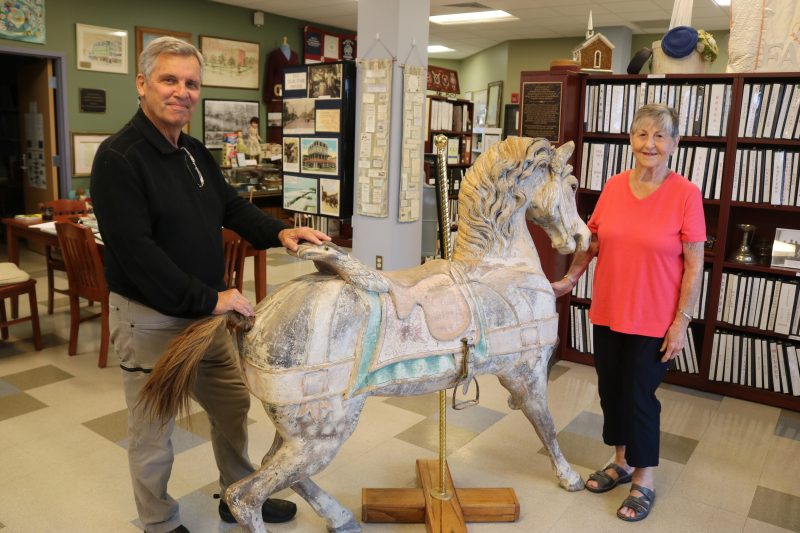 By DONALD WITTKOWSKI
The monstrous Ash Wednesday coastal storm in 1962 devastated Sea Isle City, but one lucky survivor has returned home after an absence of 60 years.
A beautifully handcrafted antique merry-go-round horse, saved from the rubble of a destroyed Boardwalk carousel one or two days after the storm crashed into the shore, now resides in the Sea Isle City Historical Museum.
The carousel horse was donated to the museum by the owner, Ann Bacon, 74, of Chestnut Hill, Pa. The ornate, wood horse was carved by the famed Philadelphia craftsmen and carousel makers, Gustav Dentzel and his son, William, in 1905, Bacon said.
The striking features include life-like eyes, a tail made of real horsehair, leather stirrups, an elaborate wood mane and the image of an eagle carved into the saddle. It stands about 4½ feet tall and 5 feet long.
“This is a pretty significant piece of history. I get goosebumps when I look at her. I want to pet her and say, ‘Welcome home,’” said Ron Kovatis, the museum president.
Kovatis referred to the horse as “her” because Ann Bacon named it “Alice” in memory of her beloved aunt, Alice Bacon.
Claire McGough, a museum volunteer, marveled over the artistry of the sculptured horse.
“I thought it was beautiful,” McGough said of her reaction when she first saw it. “For it to have survived for so many years is unbelievable.”
By DONALD WITTKOWSKI
The monstrous Ash Wednesday coastal storm in 1962 devastated Sea Isle City, but one lucky survivor has returned home after an absence of 60 years.
A beautifully handcrafted antique merry-go-round horse, saved from the rubble of a destroyed Boardwalk carousel one or two days after the storm crashed into the shore, now resides in the Sea Isle City Historical Museum.
The carousel horse was donated to the museum by the owner, Ann Bacon, 74, of Chestnut Hill, Pa. The ornate, wood horse was carved by the famed Philadelphia craftsmen and carousel makers, Gustav Dentzel and his son, William, in 1905, Bacon said.
The striking features include life-like eyes, a tail made of real horsehair, leather stirrups, an elaborate wood mane and the image of an eagle carved into the saddle. It stands about 4½ feet tall and 5 feet long.
“This is a pretty significant piece of history. I get goosebumps when I look at her. I want to pet her and say, ‘Welcome home,’” said Ron Kovatis, the museum president.
Kovatis referred to the horse as “her” because Ann Bacon named it “Alice” in memory of her beloved aunt, Alice Bacon.
Claire McGough, a museum volunteer, marveled over the artistry of the sculptured horse.
“I thought it was beautiful,” McGough said of her reaction when she first saw it. “For it to have survived for so many years is unbelievable.”
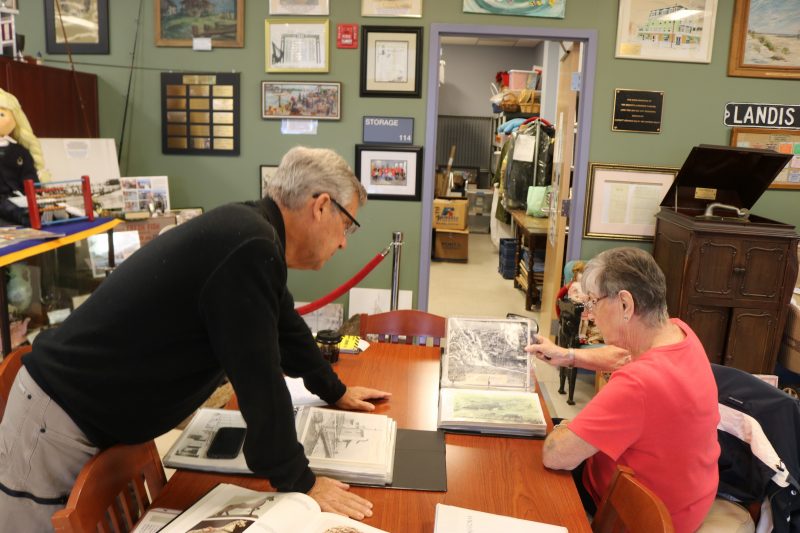 Kovatis and McGough look through old photos and records while doing research on the carousel horse and the 1962 storm.
The museum is planning to celebrate the horse’s donation with a formal welcoming ceremony. A date has not yet been set, but Kovatis said the ceremony will likely be held before Thanksgiving.
In the meantime, the horse is on public display at the museum, which is housed inside the Sea Isle City Library at 4800 Central Ave. It arrived Wednesday after Kovatis, Sea Isle’s Public Information Officer Katherine Custer and two other city workers transported it from Ann Bacon’s home in Chestnut Hill.
Kovatis repeatedly stressed the museum’s gratitude to Ann Bacon and her late father, Edward Bacon, for saving and preserving such a treasured artifact so that it could be shared with the public 60 years later.
“We are eternally grateful to Ann Bacon. She is a wonderful woman. Her generosity goes beyond recognition,” Kovatis said. “Thanks to Ann and her father, this has been preserved for 60 years for the residents and visitors of Sea Isle to see.”
For the carousel horse to have survived the epic storm, after the building that housed it was destroyed, was something of a miracle. For it to have remained carefully preserved in the possession of the same family for another 60 years is another remarkable part of its history.
In Sea Isle, there were horrifying images in 1962 of homes being swept off their foundations and floating down the street, a movie theater being buffeted by raging waves before it collapsed into the ocean and beach sand carried so far inland that it clogged the main drag of Landis Avenue.
Houses, hotels, theaters, amusement piers and boardwalks simply disappeared overnight in the storm’s fury from March 6-8, 1962, forever changing Sea Isle and other Jersey Shore towns.
Kovatis and McGough look through old photos and records while doing research on the carousel horse and the 1962 storm.
The museum is planning to celebrate the horse’s donation with a formal welcoming ceremony. A date has not yet been set, but Kovatis said the ceremony will likely be held before Thanksgiving.
In the meantime, the horse is on public display at the museum, which is housed inside the Sea Isle City Library at 4800 Central Ave. It arrived Wednesday after Kovatis, Sea Isle’s Public Information Officer Katherine Custer and two other city workers transported it from Ann Bacon’s home in Chestnut Hill.
Kovatis repeatedly stressed the museum’s gratitude to Ann Bacon and her late father, Edward Bacon, for saving and preserving such a treasured artifact so that it could be shared with the public 60 years later.
“We are eternally grateful to Ann Bacon. She is a wonderful woman. Her generosity goes beyond recognition,” Kovatis said. “Thanks to Ann and her father, this has been preserved for 60 years for the residents and visitors of Sea Isle to see.”
For the carousel horse to have survived the epic storm, after the building that housed it was destroyed, was something of a miracle. For it to have remained carefully preserved in the possession of the same family for another 60 years is another remarkable part of its history.
In Sea Isle, there were horrifying images in 1962 of homes being swept off their foundations and floating down the street, a movie theater being buffeted by raging waves before it collapsed into the ocean and beach sand carried so far inland that it clogged the main drag of Landis Avenue.
Houses, hotels, theaters, amusement piers and boardwalks simply disappeared overnight in the storm’s fury from March 6-8, 1962, forever changing Sea Isle and other Jersey Shore towns.
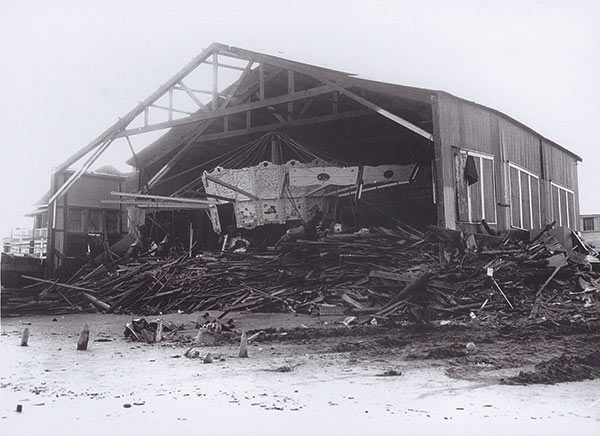
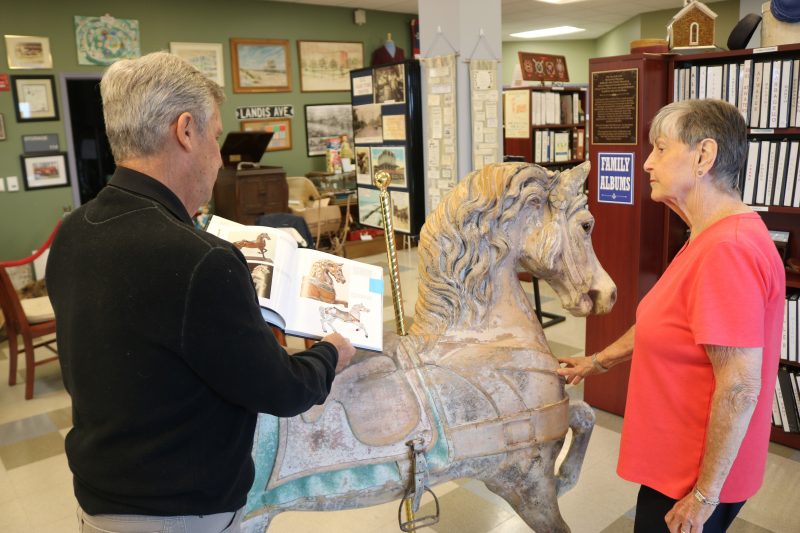 Kovatis and McGough use a photo from the book "Art of the Carousel" to compare it to the museum's antique horse.
Poring through old records and photos, Kovatis and McGough are in the midst of researching the horse’s provenance as well as the history of the 1962 storm.
Kovatis said they believe the horse was part of what was called Marconi’s Carousel, an amusement attraction located at 43rd Street and the Boardwalk and owned by the Mascuilli family. An old black-and-white photo in the museum’s possession shows the destroyed carousel building in the storm’s aftermath.
One resource that the museum staff is using is a book titled “Art of the Carousel,” written by Charlotte Dinger. The book shows a contemporary color photo of one of the carousel horses in Sea Isle plucked from the rubble of the 1962 storm.
Ann Bacon said she believes the one pictured in the book is the carousel horse that had been bought by her father’s neighbor at the same time her father purchased the other horse.
Dinger, a collector of carousel horses and an expert on antique carved horses and other carousel art, later became the owner of the neighbor’s carousel horse, Ann Bacon said. Dinger died in 1996. Apparently, her estate sold the carousel horse later on at auction, Ann Bacon said. Its current whereabouts are not known.
In the meantime, the carousel horse owned by the Bacon family is prominently displayed in the middle of the Sea Isle City Historical Museum.
While showing off the horse on Thursday, Kovatis was fascinated by its life-like glass eyes – a major part of its artistic beauty.
“If you look at her in the eyes, you would swear that she’s looking back at you,” he said. “But one way or another, it’s a piece of art, not just a piece of history.”
For more information on the Sea Isle City Historical Museum, visit seaislemuseum.com
Kovatis and McGough use a photo from the book "Art of the Carousel" to compare it to the museum's antique horse.
Poring through old records and photos, Kovatis and McGough are in the midst of researching the horse’s provenance as well as the history of the 1962 storm.
Kovatis said they believe the horse was part of what was called Marconi’s Carousel, an amusement attraction located at 43rd Street and the Boardwalk and owned by the Mascuilli family. An old black-and-white photo in the museum’s possession shows the destroyed carousel building in the storm’s aftermath.
One resource that the museum staff is using is a book titled “Art of the Carousel,” written by Charlotte Dinger. The book shows a contemporary color photo of one of the carousel horses in Sea Isle plucked from the rubble of the 1962 storm.
Ann Bacon said she believes the one pictured in the book is the carousel horse that had been bought by her father’s neighbor at the same time her father purchased the other horse.
Dinger, a collector of carousel horses and an expert on antique carved horses and other carousel art, later became the owner of the neighbor’s carousel horse, Ann Bacon said. Dinger died in 1996. Apparently, her estate sold the carousel horse later on at auction, Ann Bacon said. Its current whereabouts are not known.
In the meantime, the carousel horse owned by the Bacon family is prominently displayed in the middle of the Sea Isle City Historical Museum.
While showing off the horse on Thursday, Kovatis was fascinated by its life-like glass eyes – a major part of its artistic beauty.
“If you look at her in the eyes, you would swear that she’s looking back at you,” he said. “But one way or another, it’s a piece of art, not just a piece of history.”
For more information on the Sea Isle City Historical Museum, visit seaislemuseum.com
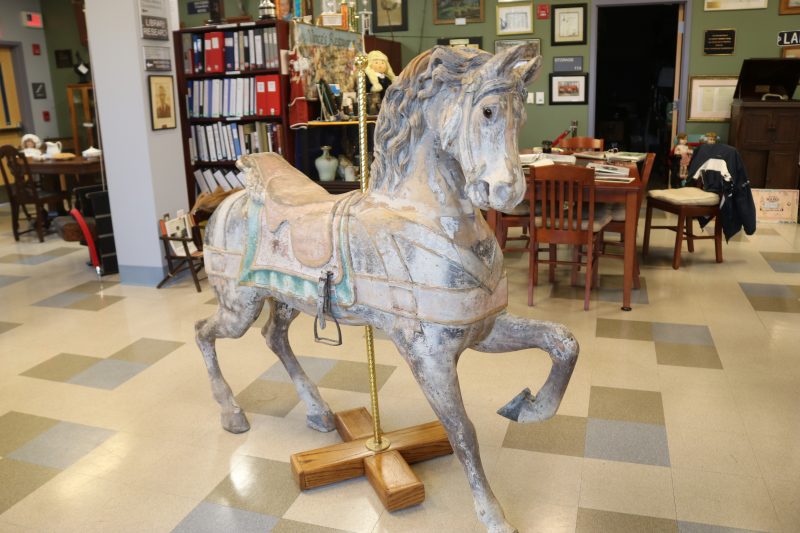 The carousel horse was hand-carved by the famed Philadelphia craftsmen Gustav Dentzel and his son, William, in the early 1900s.
The carousel horse was hand-carved by the famed Philadelphia craftsmen Gustav Dentzel and his son, William, in the early 1900s.